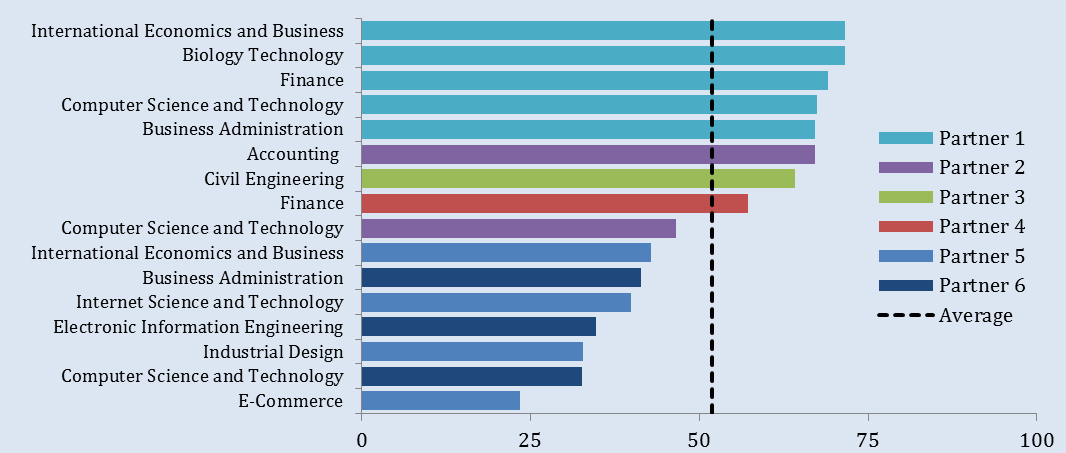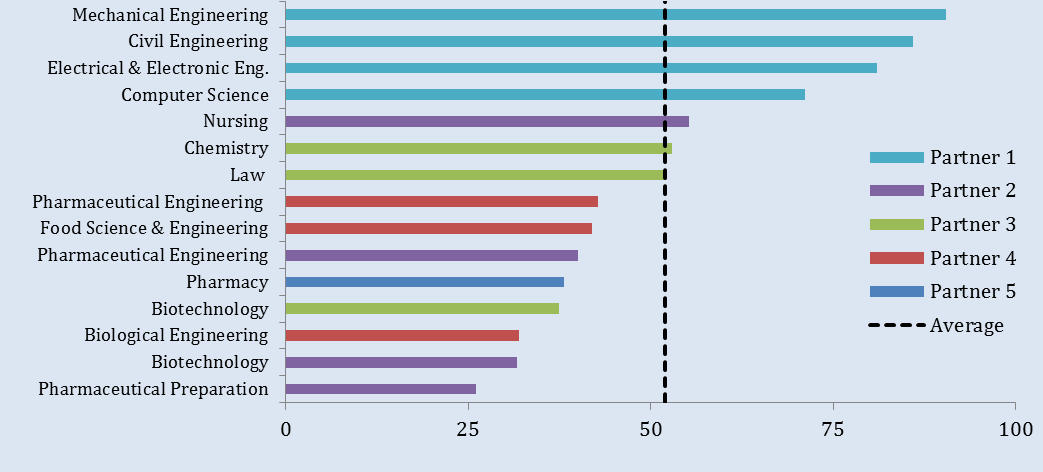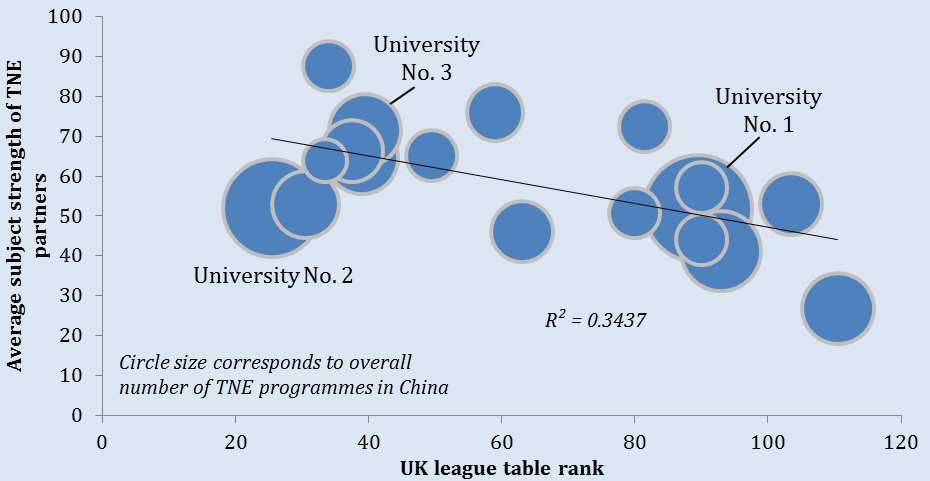Transnational education is an increasingly important component of UK universities' international strategies, and it has been widely reported that there are now more international students studying for UK qualifications abroad than there are in the UK. Partnerships with overseas universities are one of the key delivery modes for TNE programmes, and UK universities have been particularly active in establishing these partnerships in China – as of the end of 2014, there were 199 undergraduate level UK-China joint programmes formally approved by the Ministry of Education, excluding joint institutes and branch campuses.
Focus group research with prospective and current Chinese TNE students shows that the strength of the local partner is one of the most important factors when choosing a TNE programme. Students in both groups see this as at least as important as (and often more important than) the overseas university. It is therefore crucial for universities to choose the right domestic partner for their joint programmes.
While there are many factors for UK universities involved in choosing a local partner, such as location and existing international collaborations, the partner university's strength in the given subject is certainly one of the most important. However, an analysis of UK universities' TNE partners in China reveals that there is often a great deal of variation in the subject ranking of local partners
In the charts and analysis below, Chinese universities' subject strengths are compared based on the average scores of incoming students in the Gaokao, the university entrance examination taken at the end of senior secondary school. Unlike in the UK, university recruitment in China is based virtually entirely on the results of this examination; places are given to the applicants with the highest scores without considering other factors like extracurricular activities. This makes Gaokao scores a strong indicator of the attractiveness of a course, compared with the same subject at other institutions. This metric is particularly valuable from a recruitment point of view as it shows the real choices students make after considering all factors.
Variation is the rule, not the exception
There is a large amount of variation between the strengths of the different Chinese partners involved in UK-China TNE programmes, even with the same UK institution. It is not uncommon for the same UK university to have several TNE partnerships with different universities in China, including some which are strong in the relevant subject area and others which are much weaker.
The chart below shows the MoE-approved TNE partnerships of one UK institution with six different Chinese partners across a total of 11 different subjects. The scores in this chart represent the subject-specific strength of the Chinese partner institutions on a scale from 0 to 100, where 100 represents the university whose incoming students in the relevant subject have the highest Gaokao scores1.
UK university no. 1 and the subject strength of its local partners in China
The difference in the strengths of this university's various partners is immediately obvious from the above chart. Partner 1 is in the top third of Chinese universities for all five subjects that it partners on, with an overall indexed score of 69.4, while Partners 5 and 6 rank well below the national average among universities teaching these subjects in China. Even within a single subject field such as computer science, one of this UK university's partners is in the top third of institutions offering this subject in China, while another is in the bottom third. This may lead to difficulties in ensuring not only that the two programmes are of equivalent quality, but that they are seen as such by Chinese students.
For the institution in the above chart, the subject-specific rankings of each of its six partners are broadly consistent—partner 1 is above average in all five subjects, while partners 5 and 6 are well below average across the board. However, the chart below shows that this is not always the case. One of this UK university's partners—a specialist medical university—is significantly stronger in nursing than it is in other subjects such as pharmaceutical preparation. In general there is greater variation in quality across subjects at lower ranked Chinese universities, which should also factor into the key considerations of UK universities when seeking TNE partnerships in China.
UK university no. 2 and the subject strength of its local partners in China
In comparison with the two previous universities, the local partners of the UK university in the following chart are much more similar in terms of student Gaokao scores. Although its ranking within the UK is lower than that of the university shown in the second chart, this institution's partners are stronger in the relevant subjects and also show less variation. This shows that it is possible to form consistently high quality partnerships with different local universities across a range of subjects, but it requires UK universities to pay close attention to their counterparts' subject strengths.
UK university no. 3 and the subject strength of its local partners in China
Assessing the quality of UK universities' TNE partners in China
It should be no surprise that, in general, 'higher ranked' UK universities find it easier to attract 'better quality' Chinese partners (based on Gaokao entry scores) for their TNE programmes. However, the strength of this connection is significantly weaker than might otherwise be expected. There are several examples of highly placed UK universities whose Chinese partners are well below the level that might be expected given their league table rankings, while other universities that do not 'rank' as highly in the UK have joint programmes with much higher quality Chinese institutions, at least in the relevant subject areas.
The chart below illustrates the differences between UK universities' partnerships in China2. The distance of some universities from the overall trend line shows that university ranking is far from the only factor influencing the relationship. A better understanding of potential partners' strengths in the relevant subject areas can therefore provide room for UK universities to build relationships with stronger Chinese partners and enhance their international competitiveness in the process.
How local partners of the most active UK universities in TNE in China compare 
Given the importance of the domestic institution in students' TNE study decisions, partnering with a stronger institution can bring benefits both in terms of recruitment prospects as well as student quality. The attractiveness of the Chinese partner university is a key consideration of potential students, so it should also be one of the most important factors that universities consider when setting up TNE partnerships in China and other overseas markets, although the feasibility of this analysis will of course depend on the availability of subject rankings in these countries.
The example of China shows not only that some UK universities perform much better than others in forming high quality TNE partnerships in China, but that some of the best performing universities are also among the least expected. This is fertile ground for further analysis. TNE in China may remain in its infancy, but it is never too early for UK institutions to benchmark their performance.
The British Council's Services for International Education Marketing (SIEM) team helps UK institutions refine their internationalisation strategies to succeed in East Asia and around the globe. Please get in touch if you would like to learn more.
kevin.prest@britishcouncil.org.cn
1 As Gaokao examinations are administered separately in each province, the scores provided in these charts are based on an average of the university's normalised rank across all provinces where it recruits students. In each province, institutions are given a score from 0 to 100 based on their rank in terms of incoming students' average Gaokao score, with 100 being the highest (a university whose incoming students for the relevant subject in that province have a higher average Gaokao score than those at any other university) while 0 would represent the lowest. The median university, with an equal number of institutions ranked above and below, would have a score of 50. These scores are then averaged across all provinces where the university recruits students to give the final score across the country as a whole – again from 0 (worst) to 100 (best).
2 The rank of the UK university is shown on the x-axis, with higher ranked universities to the left of the chart, and is based on the average of the university's rank in the CUG and Guardian league tables. The y-axis represents the average indexed rank of the university's Chinese partners in the relevant subjects, while the size of each circle represents the number of TNE partnerships each university operates in China. The chart only covers MoE-approved TNE partnerships, excluding branch campuses and articulation arrangements.
